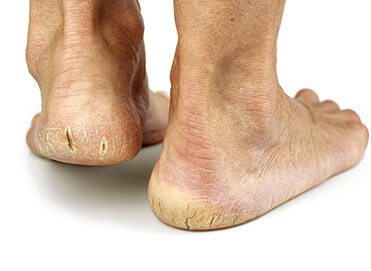Dry, cracked heels can be unsightly, and they can be cause of pain and embarrassment.
Cracked heels are caused by dryness or thickening of the skin (callus) which then cracks or breaks under pressure. If this becomes severe enough, then fissures may form.
When the skin around the heels becomes thickened and dry, it loses the natural elasticity in the skin, and can split under pressure causing painful and even bleeding heels. This can be made worse in people who have large fatty pad on the sole of their feet, which under pressure requires more elasticity in the skin to expand without cracking. This pressure can be the result of prolonged standing, pregnancy or excess weight.
Causes
- Walking around barefooted or in footwear such as thongs, sling backs or open backed sandals which dries out feet.
- Standing for long periods at work or home, especially on hard floors.
- Increased weight which causes increased pressure on the heels causing callus. With increased weight the heel is also required to expand more and hence can often crack more.
- Poor fitting shoes or sandals that don’t support the heels from expanding sideways under pressure.
- Unhygienic circumstances or conditions.
- Unhealthy, dry scaly skin that can be caused by climate, such as low humidity during dry summers or cold winters.
Medical conditions can also lead to drying of the skin such as:
- Diabetes where autonomic neuropathy leads to less sweating and thus less moisture.
- Psoriasis & Eczema.
- Fungal infections of the foot, i.e. Athlete’s foot.
Note: in the elderly, callused heels may be a sign of increased pressure and can be a precursor to a bed sore. These cases should be assessed by a podiatrist before commencing any at home treatments.
Treatment
The thickened skin needs to be reduced in severe cases prior to using moisturiser. The skin may be so dry that it is almost impossible for moisturiser to penetrate to the skin under the callus. In more severe cases you may need the help of a podiatrist. Podiatrist’s can remove the thick layer of the heel callus fairly simply. This may need to be done regularly, or if you are willing to put the work in you can use pumice stone or an emery board to give you a kick start in the right direction.
Once the callus has been reduced, the regular use of a moituriser is recommended. Below are some general guidelines to consider when treating cracked heels:
- If cracks start to bleed apply an antiseptic to prevent infection and keep clean.
- Wear closed in shoes and good socks when you can.
- Drink plenty of water to keep you and your skin hydrated.
- Investigate the cause of the problem, so this can be addressed. There may be an underlying mechanical reason for the load on the heel.
- If very painful and bleeding, strapping the heel with a rigid sports tape which may be used to ‘hold’ the cracks together while they heal.
Treatment may include gait correction that alters the stresses on the foot. This is achieved by wearing orthotics. Custom orthotics are manufactured at Gait Way podiatry in our on site laboratory.
Related Conditions
- Are Your Feet Ready For the Jetty to Jetty Fun Run?
- Australia, Thongs Are a Summer Essential!
- Callus and Corns
- Cracked Heels
- Don’t Wait Until It’s Too Late: Maximize Your Health Funds
- Ingrown Toe Nails
- Investing in Tradespeople’s Health: Why It Matters
- Moisture Socks
- National Health Month for Tradies – Protect Your Feet!
- PODIATRY CARE FOR VETERANS


